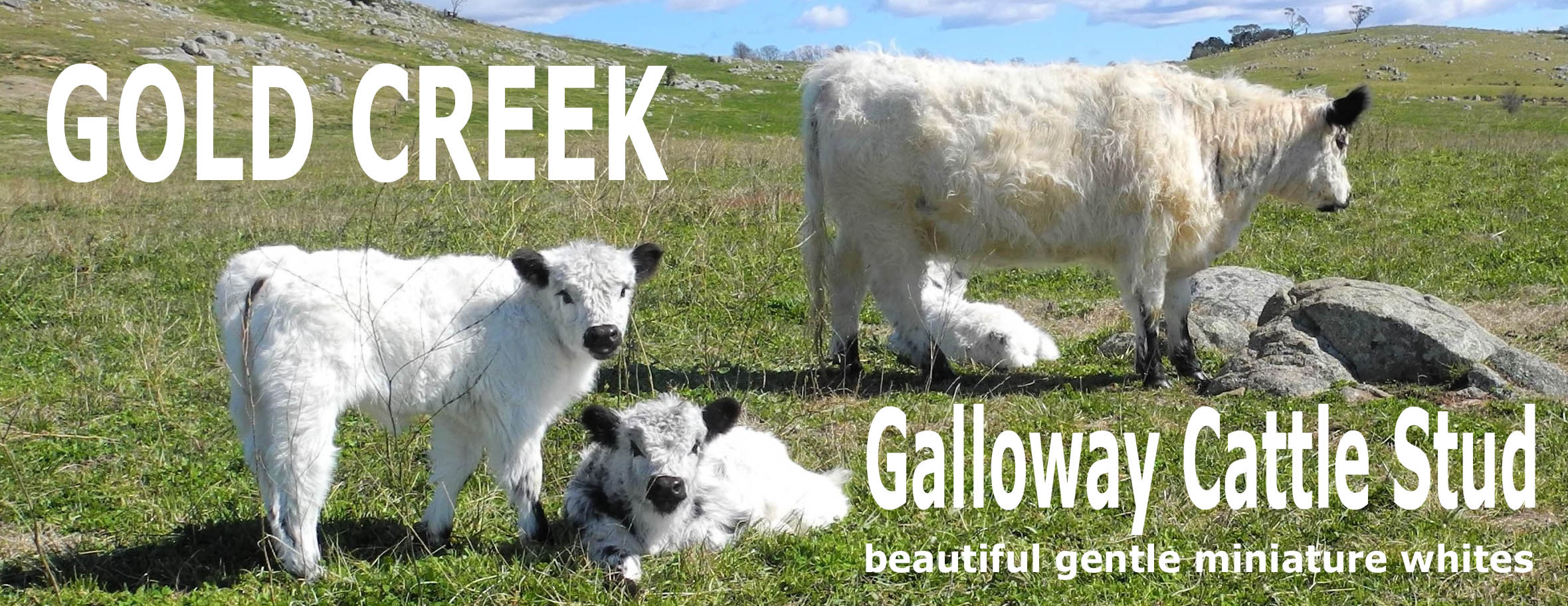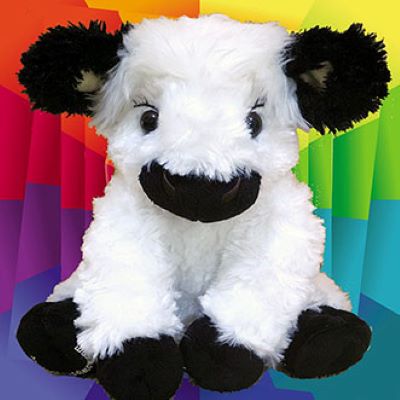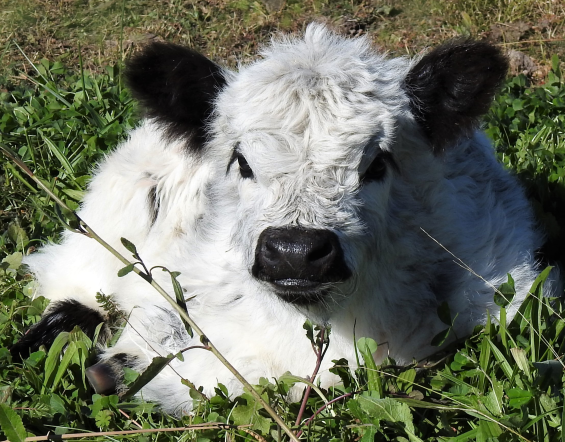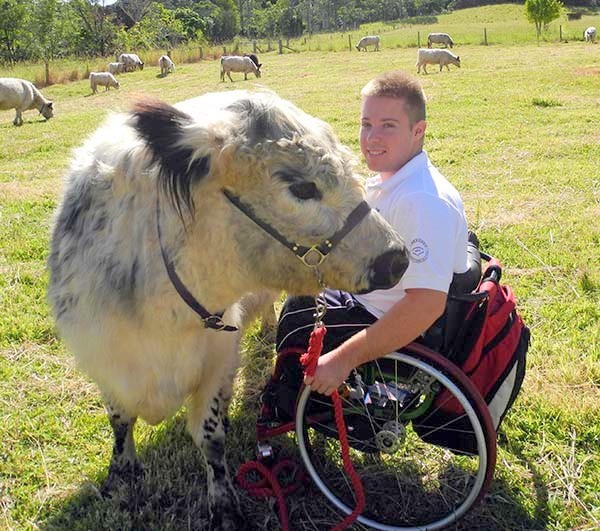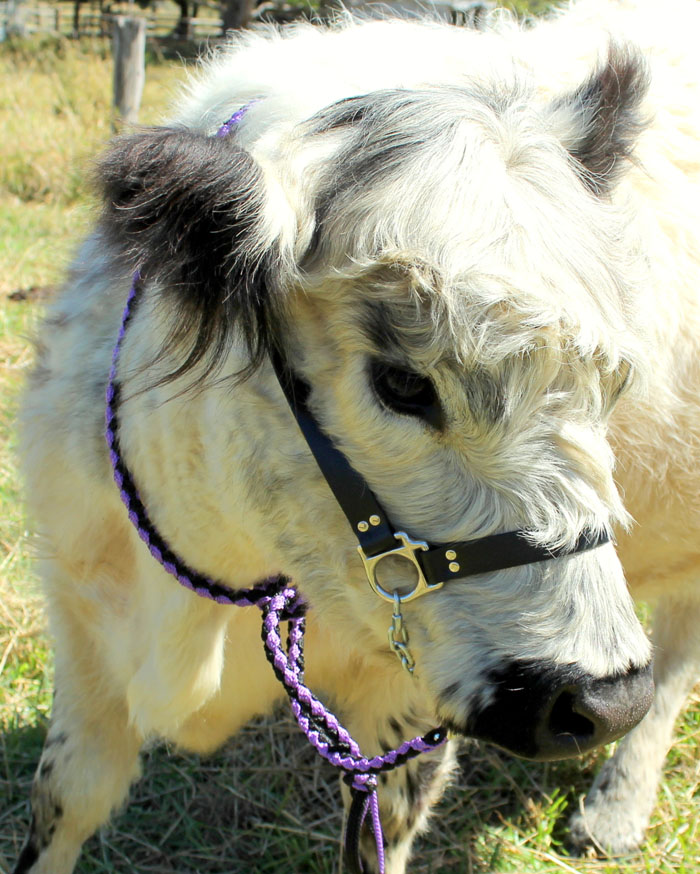Galloway cattle are a heritage livestock breed. An ancient Scottish breed they are the oldest of all British breeds. The number of registered full blood White Galloway cattle worldwide is small. We breed full blood Galloways for the pure joy of it, to increase the number of full blood Galloway cattle in Australia and to introduce this incredible breed to as many people as we can. We are very proud of our gorgeous cattle. We have chosen not to take our full blood cattle into the show ring - but you most certainly can.
GOLD CREEK FULL BLOOD - TO WIN HEARTS AND BUILD NUMBERS
In the past, we purchased many show-winning, stud breeding cattle from interstate. From that starting point, we are now breeding our GOLD CREEK stud cattle with sought after bloodlines and show ring potential. These cattle are so placid that just about anyone could show them if they felt so inclined. To date, we have chosen not to enter the show ring ourselves, but we now have other more experienced breeders taking our cattle into the show ring, and the results have been very pleasing.
We are simply content to enjoy our cattle here on the property, share them with you online and add their calves to the herd book. There is only a very limited number of full blood Miniature White Galloways registered as 'Active' in Australia - we aim to improve significantly on that number.
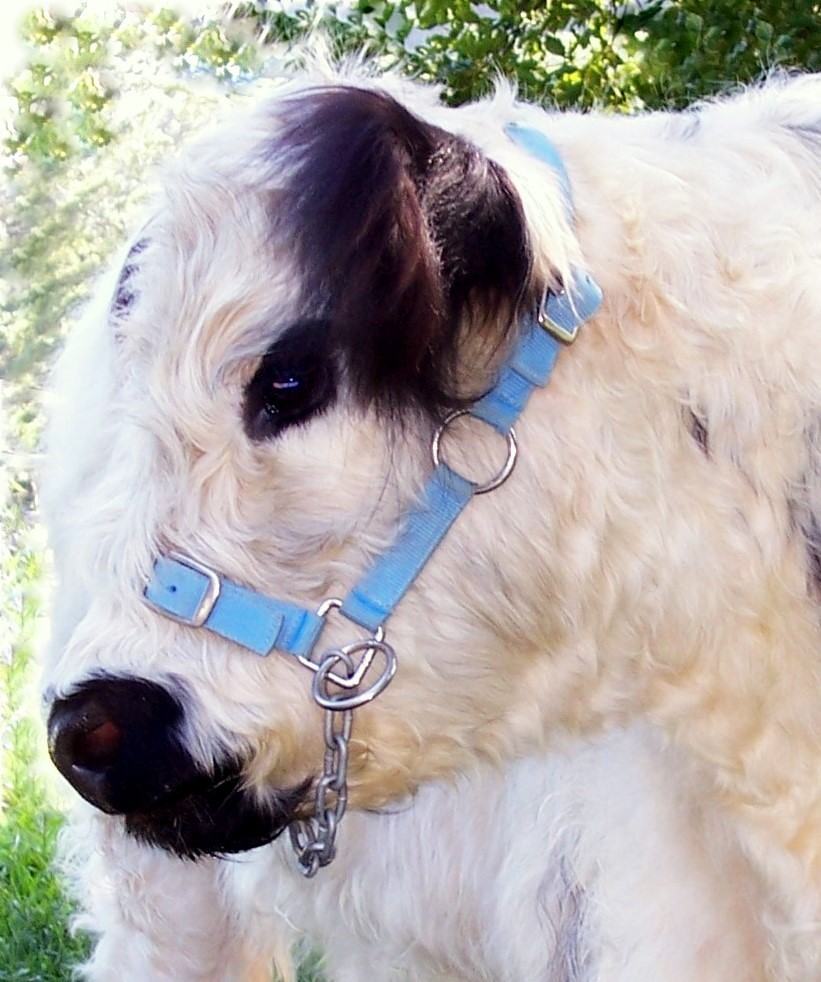
GALLOWAY ORIGIN AND HISTORY
The Galloway is a very old Scottish breed. It is the oldest known British breed on record and the oldest known polled beef breed in the world. The numbers of White Galloway were so low that they were listed as a rare breed in both Australia and New Zealand at one time.
BREED CHARACTERISTICS
Galloways, not being as tall as European breeds were once referred to as 'large cattle on short legs'. Miniature Galloways have the same breed characteristics as standard or traditional Galloways but must comply with strict height requirements. 'Miniature' Galloways are just the shorter cattle of this compact breed. There is no actual miniature gene involved in producing Miniature Galloway cattle. Their shorter height measurements have been achieved by selective breeding (or breeding down as it is also called).
Galloways are naturally polled. They are long-living, very resistant to disease, and easy to manage. They create strong hybrid vigour due to the purity of the breed.
The unique double coat of hair makes the Galloway an extremely versatile breed, able to withstand extremes of temperature and climate. Galloways, because of their extra hair, can actually gain weight when on the same ration as other cattle which are losing weight.
Galloways have an amazing ability to forage on sparse hill conditions, yet also perform outstandingly on high-grade pasture. Galloways are being sought after to improve marginal lands, as they graze non-selectively. Non-selective grazing encourages better quality grasses while at the same time does not allow the poorer quality species to take over.
One of the most notable characteristics of the Galloway female is her ability to rear calves naturally under all conditions. In Australia, the Galloway has proven itself not only in cold climates but also in the hot inland, where Galloway cross cows have survived severe droughts while rearing a healthy calf.
Galloways are an extremely fertile breed, regularly producing vigorous live calves. The cow is noted for ease of calving, being a protective mother and having an abundant supply of milk. A sustained lactation period ensures a strong, well-nourished calf at weaning. The maternal attributes of the Galloway cow came out tops in a study at the famous Clay Animal Research Center, Nebraska, USA. Eleven breed groups were tested for their ability to give birth and rear their calves. Of the 11 breed groups included in the study, the Galloways recorded the highest weaning percentage (95.5%), the highest calf survival percentage (95.2%), and an outstandingly low incidence of calving difficulty (0.8%).
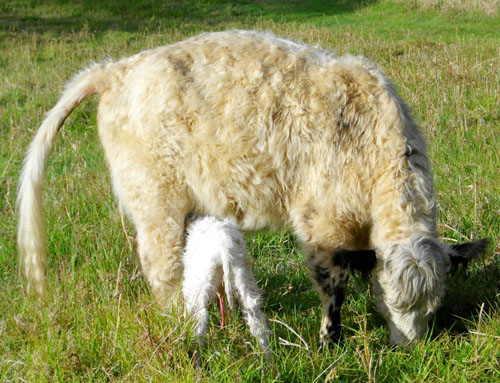
* In 2009 Cuddles calves and hardly blinks an eye. Her perfect little heifer calf was up and suckling in minutes and Cuddles was back to eating grass!
Yes, that is the red, wet umbilical cord you can see. So yes it would seem that it is true what they say about Galloway cows and ease of calving.
It is also true what they say about Galloway cows and calf survival to weaning - if a Galloway cow loses a calf you can be pretty sure it was for reasons beyond her control (paralysis tick, snake bite...) Galloway cows 'give their all' to their calves.
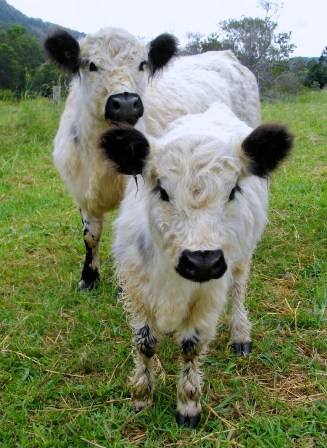
With the Galloway's non-selective grazing habits, Galloway beef can be raised under extensive conditions. Research carried out shows that beef which is extensively produced can be of great benefit in a healthy diet. Galloway beef is rich in linoleic acid, which reduces the dangerous type of cholesterol (LDL), prevents thrombosis and, therefore, protects coronary vessels.
The carcass of the Galloway is of excellent quality, with high yields. By using Galloways and their crosses it is easy to obtain fat cover and heavy muscling to suit most trade requirements and new marketing techniques. Galloway steers have gained much success in both carcass competitions and grazing trials. The high yield of Galloway and Galloway cross steers makes them a very attractive item for the feedlots, as the higher the yield, the higher the profit per animal.
NB: This information is based on the NSW Dept of Primary Industries: Agriculture Agfact A2.3.36
OUR ORIGINAL HERD
Our original full blood females were predominantly from the very successful, well known Castle Douglas bloodline.
Wanting to inject some new blood into our herd we searched Australia high and low for full blood bulls from a different bloodline to purchase. We did not have any success, so our search eventually led us to complete an Artificial Insemination course in 2008 and to then source high-quality straws from overseas.
Courtesy of another Galloway breeder, we started using straws from a magnificent, full blood, Miniature White Galloway bull from overseas. The calves from this breeding line are helping us to avoid the ongoing problem of bloodlines becoming too close in the Miniature White Galloway cattle in Australia.
BUILDING OUR HERD
Early in 2010 we were able to purchase eight more beautiful Castle Douglas full blood Miniature White Galloway females and two bull calves directly from the Castle Douglas Stud. Again, many of these cattle came to us having won ribbons at shows in the southern states, prior to our purchase. The Castle Douglas Stud, in Braidwood NSW, was the original home of the Miniature Whites. After decades of success, stud owners Roger and Fran Rankin were wanting to retire from breeding and showing their prize-winning Galloways. We were very fortunate to be able to procure these incredible females from the Rankins. It gave us access to the many, many years of experience that went into breeding these magnificent females and an open line of communication to the wisdom of the two people responsible for putting it all in place. It doesn't get much better than that.
Six of these Castle Douglas stud females calved mid-2010, producing two more beautiful little heifers to add to our stud breeding 'team'.
By mid-2011 we were able to put our first full blood Miniature White Galloway bull to work. Castle Douglas Nemo is a docile, well-formed, rather small bull. His progeny in 2012 were absolutely gorgeous and nearly all heifers - we were rapted.
We were really looking forward to seeing Nemo's calves on the ground throughout 2013 - especially those from the cows that already carry the bloodline from overseas. Two beautiful heifers, GOLD CREEK Snuggle and GOLD CREEK Jelly Bean did not disappoint us.
Six calves were registered in 2014, half of them full blood.
In anticipation of moving our herd south, we did not put all of our cows into calf during 2015 - 2016 so births and registrations were very low.
Now that the herd is grazing safely in Braidwood NSW the calves throughout 2017 and 2018 have been everything we have hoped for and more. All the little steers sold well as pets. The six new purebred and full blood small heifers are a delight. We will monitor their breeding progress with great interest.
Due to drought conditions, we didn't have any calves in 2019, we registered one in 2020 and none in 2021. After constant rain and leasing a small red bull in late 2021 we can say that 2022 is looking promising.
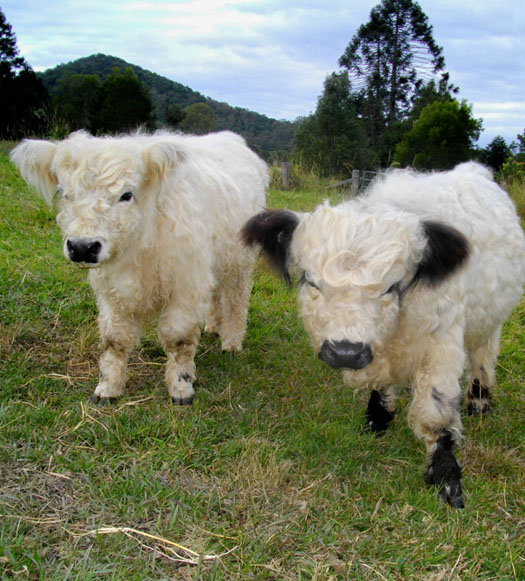
Castle Douglas Nemo in 2010 (with his pal Old Spice on his left). Our very beautiful boys.
Artificial Insemination Procedure
In the hope of finding a better way of delivering the semen with our small miniature cattle we further investigated the actual Artificial Insemination procedure. We were successful and are now implementing a procedure that is specifically designed to be less stressful for the cows and far more 'user-friendly' for our little heifers.
THE FUTURE
Building our herd of full blood Miniature White Galloways, and introducing this docile breed to others, has been a very satisfying experience. We are very proud of what we have achieved to date and we are really looking forward to what the future may bring.
We now have one of the most beautiful herds of full blood Miniature White Galloway cattle in Australia. This is only our totally biased opinion and still a small herd, given the limited number in Australia. But, it gives us a sense of pride in our achievements nonetheless.
Given a choice, we would choose Miniature White Galloways time and time again. It has been our experience, that the Miniature Galloway is the most docile and affectionate in nature of all the different breeds of miniature cattle. They are the perfect animal for people wanting beautiful cattle to show, docile cattle as pets and great foragers for any small acreage pasture management needs.
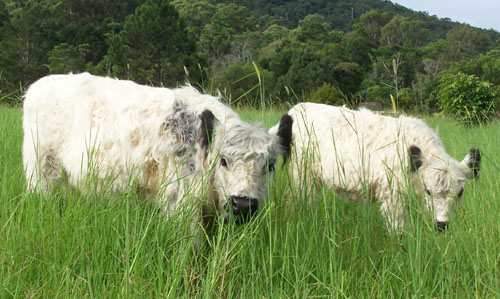
A Full Blood Miniature White Galloway heifer with black points - early 2010.
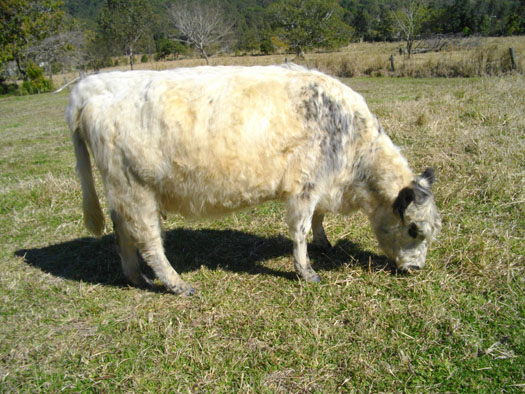
The same Full Blood Miniature White Galloway heifer just before she calved mid-2011.
![]() This email address is being protected from spambots. You need JavaScript enabled to view it.
This email address is being protected from spambots. You need JavaScript enabled to view it.
